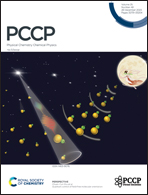Modulating the electronic properties and band alignments of the arsenene/MoSi2N4 van der Waals heterostructure via applying strain and electric field†
Abstract
The two-dimensional (2D) MoSi2N4 monolayer fabricated recently has attracted extensive attention due to its exotic electronic properties and excellent stability for future applications. Using first-principles calculations, we have shown that the electronic properties of the arsenene/MoSi2N4 van der Waals (vdW) heterostructure can be effectively modulated by applying in-plane/vertical strain and vertical electric field. The arsenene/MoSi2N4 vdW heterostructure has type-II band alignment, facilitating the separation of photogenerated electron–hole pairs. The heterostructure is predicted to have an indirect bandgap of about 0.52 eV by using the PBE functional (0.87 eV by using the hybrid functional). Furthermore, under εz = 0.5 Å vertical tensile strain or −0.05 V Å−1 vertical electric field, the arsenene/MoSi2N4 heterostructure can not only experience transition from an indirect to a direct bandgap semiconductor, but also exhibit type-II to type-I band alignment transition. The calculated optical absorption properties reveal that the formation of the vdW heterostructure can effectively enhance the light absorption, and the absorption coefficient in visible and ultraviolet regions is much higher than those of the arsenene and the MoSi2N4 monolayer. Most importantly, based on charge transfer analysis, we proposed the modulation mechanism of the electronic properties of the vdW heterostructure influenced by vertical strain and electric field. Our study provides physical insights into manipulating the electronic and optoelectronic properties of MoSi2N4 based vdW heterostructures, which may be helpful for their practical applications.



 Please wait while we load your content...
Please wait while we load your content...